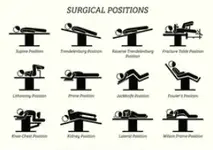
COMMON SURGICAL POSITIONS FOR OPERATING TABLES
Surgical procedures require proper patient positioning to keep the patient comfortable and safe during surgery and provide the surgeon with easy, unobstructed access to the surgical site. Many factors influence the decision of how to position a patient during a procedure:- The patient's overall condition
- Length of procedure
- Techniques to be used during the procedure
- Required exposure at the operative site
- Expected anatomical and physiological changes associated with anesthesia
- Long procedures (3+ hours)
- Bone and joint conditions
- Skin breakdown due to aging
- Malnutrition, hypovolemia, anemia, paralysis, obesity, extreme thinness, or diabetes
- Supine: This position is the body's natural position at rest, making it the most common posture for surgery. Common complications associated with the supine position are backaches and pressure-point reactions.
- Trendelenburg: The Trendelenburg position is a variation of the supine position. The upper torso is lowered and the feet raised, allowing for optimal visualization of the pelvic organs during laparoscopy and lower abdominal procedures.
- Reverse Trendelenburg: Commonly known as the head-up and feet-down position, the reverse Trendelenburg is often used in head and neck procedures
- Prone: In this position, the patient lies flat on their stomach and their head is turned to the side. This position is most commonly used for cervical spine, back, and rectal area procedures.
- Lithotomy: While in the lithotomy position, the patient is in the supine position and their legs are raised and abducted. Stirrups are needed for this position.
- Sitting: Also known as Fowler's position, the patient in this position is sitting at a 90-degree angle. The knees are slightly flexed and the feet are placed against a padded footboard. This position is ideal for neurosurgery, facial operations, and some shoulder surgeries.
- Lateral: The lateral position places the patient on the non-operative side to perform surgery on the hip, chest, or kidney.
COMMON PATIENT POSITIONS
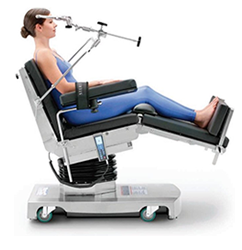
Fowler's Position
Fowler's position, also known as the sitting position, is typically used for neurosurgery and shoulder surgeries. The beach chair position is often used for nasal surgeries, abdominoplasty, and breast reduction surgeries. When positioning a patient in Fowler's position, the surgical staff should minimize the degree of the patient's head elevation as much as possible and always maintain the head in a neutral position. The patient's arms should be flexed and secured across the body, the buttocks should be padded, and the knees flexed 30 degrees. In Fowler's position, the patient is at an increased risk for air embolism, skin injury from shearing and sliding, and DVT forming in the patient's lower extremities. In this position, a patient has an increased pressure risk in their scapulae, sacrum, coccyx, ischium, back of knees, and heels.High Fowler's Position
In High Fowler's position, the patient is usually seated (Fowler's position) at the head end of the operating table. The upper half of the patient's body is between 60 degrees and 90 degrees in relation to the lower half of their body. The legs of the patient may be straight or bent.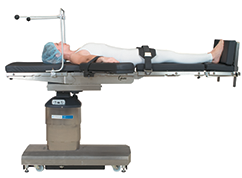
Supine Position
Supine position, also known as Dorsal Decubitus, is the most frequently used position for procedures. In this position, the patient is face-up. The patient's arms should be tucked at the patient's sides with a bedsheet, secured with arm guards to sleds. The arms may be flexed and secured across the body or extended and secured on padded arm boards. Supine position is commonly used for the following procedures: intracranial, cardiac, abdominal, endovascular, laparoscopic, lower extremity procedures, and ENT, neck, and face. In the Supine position, the patient may risk pressure ulcers and nerve damage. This position causes extra pressure on the skin and bony prominences over the occiput, scapulae, elbows, sacrum, coccyx, and heels.Jackknife Position
Jackknife position, also known as Kraske, is similar to Knee-Chest or Kneeling positions and is often used for colorectal surgeries. This position places extreme pressure on the knees. While positioning, surgical staff should place extra padding for the knee area.Kidney Position
The kidney position resembles a lateral position, except the patient's abdomen is placed over a lift in the operating table that bends the body to allow access to the retroperitoneal space. A kidney restis placed under the patient at the location of the lift.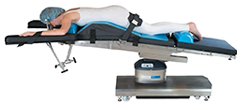
Prone Position
In the Prone position, the patient is face-down with their head in a neutral position without excessive flexion, extension or rotation. A face positioner is used when the patient's head is in the midline. The prone position is often used for spine and neck surgeries, neurosurgery, colorectal surgeries, vascular surgeries, and tendon repairs. Foam orgel positioners may also be used for spinal procedures. When a patient is in Prone, pressure should be kept off of the eyes, cheeks, ears, and breast. At a minimum, four members of the surgical staff should be available when turning a patient prone. Risks associated with Prone position include increased abdominal pressures, bleeding, compartment syndrome, nerve injuries, cardiovascular compromise, ocular injuries, and venous air embolism.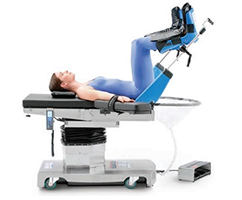
Lithotomy Position
In Lithotomy position, the patient can be placed in either a boot style leg holder or stirrup style position. Modifications to this position include low, standard, high, exaggerated, or hemi. This position is typically used for gynecology, colorectal, urology, perineal, or pelvis procedures. The risks posed to a patient in a Lithotomy position for a procedure include fractures, nerve injuries, hip dislocation, muscle injuries, pressure injuries, and diminished lung capacity. While positioning a patient in this position, surgical staff should avoid hyperabduction of the patient's hips and leaning against their inner thighs. Stirrups used on a patient in this position should disperse support and pressure over wide areas.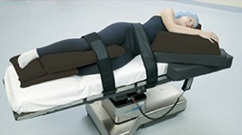
Sim's Position
The Sims' position is a variation of the left lateral position. The patient is usually awake and helps with the positioning. The patient will roll to his or her left side. Body Restraints are used to safely secure the patient to the operating table. Keeping the left leg straight, the patient will slide the left hip back and bend the right leg. This position allows access to the anus.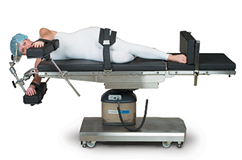
Lateral Position
A patient may be positioned in a Lateral position during back, colorectal, kidney, and hip surgeries. It's also commonly used during thoracic and ENT surgeries, and neurosurgery. Some variations on this position include Lateral Kidney, Lateral Chest, and Lateral Jackknife positions. In the Lateral position, the patient may be placed on either their left or right side depending on the side of the surgical site. A pillow or head positioner should be placed under the patient's head with the dependent ear assessed after positioning. The patient's physiologic spinal and neck alignment should be maintained during the procedure, and a safety restraintshould be secured across the patient's hips. Risks to a patient in a Lateral position include pressure to points on the dependent side of the body such as ears, shoulders, ribs, hips, knees, and ankles, as well as brachial plexus injury, venous pooling, diminished lung capacity, and DVT. A pressure-reducing OR mattress or tabletop pad should be used as needed.More on positions here:


